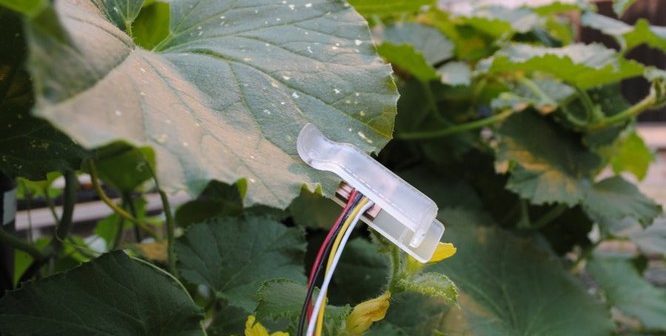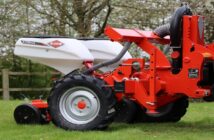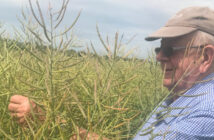Plant-based sensors that measure the thickness and electrical capacitance of leaves show great promise for telling farmers when to activate their irrigation systems, preventing both water waste and parched plants, according to researchers in Penn State’s College of Agricultural Sciences.
Continuously monitoring plant “water stress” is particularly critical in arid regions and traditionally has been done by measuring soil moisture content or developing evapotranspiration models that calculate the sum of ground surface evaporation and plant transpiration. But potential exists to increase water-use efficiency with new technology that more accurately detects when plants need to be watered.
For this study, recently published in Transactions of the American Society of Agricultural and Biological Engineers, lead researcher Amin Afzal, a doctoral degree candidate in plant science, integrated into a leaf sensor the capability to simultaneously measure leaf thickness and leaf electrical capacitance, which has never been done before.
The work was done on a tomato plant in a growth chamber with a constant temperature and 12-hour on/off photoperiod for 11 days. The growth medium was a peat potting mixture, with water content measured by a soil-moisture sensor. The soil water content was maintained at a relatively high level for the first three days and allowed to dehydrate thereafter, over a period of eight days.
The researchers randomly chose six leaves that were exposed directly to light sources and mounted leaf sensors on them, avoiding the main veins and the edges. They recorded measurements at five-minute intervals.
The daily leaf-thickness variations were minor, with no significant day-to-day changes when soil moisture contents ranged from high to wilting point. Leaf-thickness changes were, however, more noticeable at soil-moisture levels below the wilting point, until leaf thickness stabilized during the final two days of the experiment, when moisture content reached 5 percent.
The electrical capacitance, which shows the ability of a leaf to store a charge, stayed roughly constant at a minimum value during dark periods and increased rapidly during light periods, implying that electrical capacitance was a reflection of photosynthetic activity. The daily electrical-capacitance variations decreased when soil moisture was below the wilting point and completely ceased below the soil volumetric water content of 11 percent, suggesting that the effect of water stress on electrical capacitance was observed through its impact on photosynthesis.
“Leaf thickness is like a balloon — it swells by hydration and shrinks by water stress, or dehydration,” Afzal said. “The mechanism behind the relationship between leaf electrical capacitance and water status is complex. Simply put, the leaf electrical capacitance changes in response to variation in plant water status and ambient light. So, the analysis of leaf thickness and capacitance variations indicate plant water status — well-watered versus stressed.”




